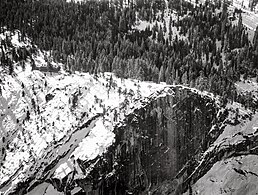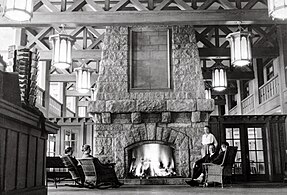Glacier Point Hotel
| Glacier Point Hotel | |
|---|---|
 The Glacier Point Hotel veranda. | |
 | |
| General information | |
| Location | Glacier Point, Yosemite National Park, California, United States |
| Coordinates | 37°43′51″N 119°34′22″W / 37.73083°N 119.57278°W |
| Opening | 1918 |
| Closed | July 9, 1969 |
| Management | Yosemite Park & Curry Company |
| Technical details | |
| Floor count | 3 |
| Design and construction | |
| Architect(s) | Daniel Gutlebin[1] |
| Developer | The Desmond Park Service Company |
| Other information | |
| Number of rooms | 80 |
The Glacier Point Hotel was a historic chalet-style hotel, located at 7,240 feet (2,207 m) above sea level, the highest elevation for a hotel in the West. Constructed in 1917 in the rustic style, it was an architectural marvel with stunning views of Half Dome and Yosemite Valley. Notable for its massive fireplace, carved from a single boulder weighing over a million kilograms, the hotel was also the venue for the iconic Yosemite Firefall spectacle where burning embers were pushed off the point to create a visually stunning 'burning waterfall'. Despite its unique location and features, the hotel grappled with numerous challenges such as a short tourist season, a remote location, and water shortages. After severe damage due to heavy snowfall in the winter of 1968-69, the hotel was destroyed by an electrical fire in July 1969. Despite proposals for rebuilding, including the idea of an aerial tramway by MCA, the site eventually became subject to restrictions against commercial development. Today, remnants of the hotel's foundations remain at the site, along with a granite amphitheater and a visitor center.
History[edit]
Glacier Point Hotel, the highest hotel in the West at 7,240 feet (2,210 m) above sea level, was a marvel in its time, featuring a massive double-sided fireplace and stunning views. Built in 1917, it stood an impressive 3,274 feet (998 m) above the valley, providing an unrivaled panorama of Half Dome and Yosemite Valley.[2]
Construction[edit]
Costing a substantial $250,000 to build, the hotel offered 125 rooms, which rented for between $4 and $5 per night.[3] Its construction by The Desmond Park Service Company and Gutleben Brothers was a feat of logistics, involving over 100 mules and trucks to transport building materials through the area's challenging terrain.[4] The construction lumber was sourced from trees near the hotel.[5]
The hotel's centerpiece was a huge fireplace, carved from a single nearby boulder, weighing an incredible 2,462,000 pounds (1,117,000 kg) — equivalent to the granite needed for a six-room house. The main building featured dining and lounge spaces. Advertising for the hotel highlighted its spacious viewing porch, offering cliffside vistas of Yosemite Valley.[6]
The hotel sat adjacent to the Mountain House, a rustic tavern built by innkeeper Charles Perego at the overlook in 1873.[7] In the years following the opening of the Glacier Point Hotel, the Mountain House was used for employee housing and put into service as a public cafeteria.
Yosemite Park & Curry Company[edit]
In 1920, DJ Desmond stretched his company's finances too thin, which led to the firm being reorganized by ABC Dohrmann[8] and Larry Harris, both prominent San Francisco businessmen. They reformed it under the name of the Yosemite National Park Company.[9] Four years later, in 1924, the government mandated a merger between the Curry Company and the Yosemite National Park Company. This merger led to the creation of the Yosemite Park & Curry Company, which subsequently took ownership of the Glacier Point Hotel.[10]
Firefall[edit]

Beginning in the 1920s, the guests of the Glacier Point Hotel would witness and participate in the Yosemite Firefall.[11] What was once a summer event would gradually become daily routine. At 9:00 every night, hotel employees would push burning embers off Glacier Point to fall 3,000 feet (910 m) down and mark the end of a performance at Camp Curry on the valley floor. As the coals fell in a set pattern, the resulting shower would closely resemble a burning waterfall.[12] This tradition would continue until the last firefall on Thursday, January 25, 1968.[13]
Operational Challenges[edit]
Although the Glacier Point Hotel was in an excellent location, it still struggled as a business. High room costs would continually leave several rooms vacant, but this would slowly change as the hotel gained favor with the increasing numbers of tourists.
During its seasonal operation, the Glacier Point Hotel opened from late spring to early autumn, from May 15 to October 1. Visitors could reach the hotel from Yosemite Valley via horseback or a 4-mile hiking trip. From around June 15, daily automobile stage services were also available for access.[14]
To improve access, the idea of an elevator carved into the cliffside was briefly considered as a solution to bypass the arduous four-mile hike or two-hour car journey from the valley.[15] However, the hotel persistently struggled with water shortages, often leading to early closures in August.
Winter presented its own challenges. The frequent snowfalls in the area necessitated constant attention due to the hotel's light construction. Maintenance workers often lived on-site, their main task being to clear the roofs of snow to prevent them from collapsing under its weight.[16]
- Glacier Point Hotel from the air.
- The double-sided fireplace, carved from a nearby boulder.
- Chalet-style architecture.
- Snoewshoeing in winter.
- Heavy snowfall reaching the second story.
Calamities[edit]
The remote hotel was perpetually threatened by wildfires. In 1936, a potentially destructive fire was successfully extinguished, preventing damage to the hotel.[17]
During the winter of 1969, the hotel, along with the McCauley Mountain House, were severely damaged by snowfall.[18] While repairs to the structures were performed, no guest reservations were booked, and the employees used the Mountain House to sell snacks to Glacier Point visitors.
On July 9, 1969, an electrical fire started on the bottom floor of the still-unoccupied hotel.[19] Within minutes, the Glacier Point Hotel, along with the Mountain House and several trees, was destroyed.[20] A nearby stockpile of Red Fir left over from the firefall helped feed the flames. After the incident, visitors were kept away from Glacier Point as demolition crews removed the remaining debris.
YPCC considered rebuilding a hotel at Glacier Point, but the Park Service would not permit rebuilding at the same location; it would have to be placed further back from the precipice.
Redevelopment Controversy[edit]
In 1974, MCA, an entertainment conglomerate which had acquired the Yosemite Park and Curry Company, put forward a proposal to construct the Glacier Park Tramway. The proposed aerial tramway was intended to create a connection between the valley floor and a newly reconstructed Glacier Point Hotel. MCA, also the operator of Universal theme parks, faced substantial opposition to their plan.
Prominent organizations like the Sierra Club, alongside many private citizens, mounted a vigorous campaign against the plan, petitioning the federal government to intervene and limit the scope of the project.[21] John Burton, U.S. House of Representatives member for San Francisco, voiced his opinion on the Yosemite situation, stating, "Natural areas like Yosemite should remain in the natural state and not be transformed into Disneylands. They are public reserves, not to be exploited."[22]
As a result of these objections, the Yosemite General Management Plan was enacted in September 1980. This plan crucially incorporated permanent restrictions designed to prevent future commercial development at Glacier Point.[23]
Legacy[edit]
In later years, a granite amphitheater was built on the site of the hotel, and a new visitor center was completed nearby.[24] These changes were part of a 1996-1997 modernization effort to transform the heavily traveled path.[25] Even so, some evidence of the Glacier Point Hotel, such as some of the old foundations, are still evident. The iconic boulder behind the hotel has also remained in its original position.[26]
See also[edit]
References[edit]
- ^ "Yosemite Historic Photo Collection". National Park Service Digital Assets. Retrieved 2023-07-26.
- ^ "Formal Opening at Glacier Point Hotel". Merced County Sun, Volume LI, Number 27, 20 July 1917. Retrieved 2024-04-30.
- ^ "Glacier Point Hotel Advertisement". San Francisco Call, Volume 102, Number 30, 4 August 1917. Retrieved 2024-04-30.
- ^ "New Quarter Million Glacier Point Hotel in Yosemite Open Tonight". San Francisco Call, Volume 102, Number 18, 21 July 1917. Retrieved 2024-04-30.
- ^ "Glacier Point Hotel". The Historical Marker Database. Retrieved 2023-07-26.
- ^ "New Quarter Million Glacier Point Hotel in Yosemite Open Tonight". San Francisco Call, Volume 102, Number 18, 21 July 1917. Retrieved 2024-04-30.
- ^ "Historic Ashes: Glacier Point Hotel 1969". National Park Service. Retrieved 2024-04-30.
- ^ "Dohrmann Building", Wikipedia, 2020-07-25, retrieved 2021-01-03
- ^ "Facebook Groups". www.facebook.com. Retrieved 2021-01-03.
- ^ "Yosemite Park and Curry Company Collection". Online Archive of California. Retrieved 2023-08-02.
- ^ Sara E. Pratt (2017-12-14). "Benchmarks: January 25, 1968: The last firefall: A Yosemite tradition flames out". Earth Magazine. Retrieved 2023-07-26.
- ^ "Glacier Point". Yosemite Nature Notes. XXXV (6): 90. June 1956.
- ^ "Spectacular Yosemite Firefall Eliminated". Madera Tribune. Vol. 76, no. 179. Madera, CA. 1968-01-26. Retrieved 2023-07-23.
- ^ Rules and Regulations. United States Department of the Interior. 1921. p. 65.
- ^ "Glacier Point to Have Elevator". Merced County Sun, Volume LIV, Number 15, 30 April 1920. Retrieved 2023-07-25.
- ^ "Yosemite Reports Record Snowfall". Imperial Valley Press, 30 January 1933. Retrieved 2023-07-26.
- ^ "Remember When". Madera Tribune, Volume 65, Number 76, 11 August 1956. Retrieved 2023-07-26.
- ^ "Snow Damage Closes Casino in Yosemite". San Bernardino Sun, 1 June 1969. Retrieved 2023-07-26.
- ^ "Hotel Burns at Yosemite". The Times. San Mateo CA. 10 July 1969. Retrieved 7 July 2014.
- ^ "The Yosemite of Yesteryear (Part 2) – La Casa Nevada, Cosmopolitan, Mountain House Hotel". Yosemite Tales. Retrieved 2023-07-26.
- ^ United States House of Representatives (December 20, 1974). National Park Service Planning and Concession Operations. Ninety-Third Congress Second Session. House of Representatives. pp. 290–291.
{{cite book}}: CS1 maint: date and year (link) - ^ "Congress May Weaken Nat'l Park Concessions". California Aggie. Vol. 95, no. 45. 8 June 1977.
- ^ "Yosemite National Park General Management Plan" (PDF). National Park Service. September 1980. Retrieved 13 July 2023.
- ^ United States National Park Service (2004). A Sense of Place: Design Guidelines for Yosemite National Park. p. 259.
- ^ Paul McHugh (August 27, 1997). "New Lodge Built at Yosemite Glacier Point is home of $2.7 million ski hut". San Francisco Chronicle. Retrieved 2012-02-03.
- ^ "Glacier Point Amphitheater". Yosemitehikes.com. Retrieved 2012-02-04.
Bibliography[edit]
- Radanovich, Walter. Yosemite National Park and Vicinity. Arcadia Publishing, 2006


 French
French Deutsch
Deutsch





